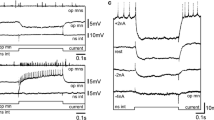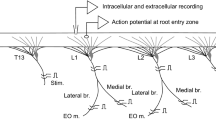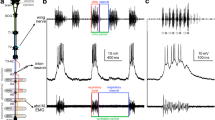Abstract
The connection between a visceral ganglia interneuron initiating bursting pacemaker activity in the RPal neuron and the RPal neuron itself was investigated inHelix pomatia. Stimulating the interneuron either initiated or intensified bursting activity in the RPal neuron, depending on initial electrical activity in this cell. Replacing calcium with magnesium ions in the extracellular fluid and adding CdCl2 to this fluid reversibly inhibited the effect of interneuronal stimulation on the RPal neuron. The latter effect was unaffected by increasing the concentration of extracellular Ca2+ 10 to 70 mM. Intracellular injection of both Cs+ and TEA into the interneuron produced an increase in the duration of its action potentials and rendered the link connecting the neurons more effective. It is deduced that a monosynaptic chemical connection exists between the interneuron and the RPal neuron for which a peptide compound serves as transmitter.
Similar content being viewed by others
Literature cited
N. I. Kononenko, "Modulation of the endogenous activity of aHelix pomatia burster neuron," Neirofiziologiya,9, No. 6, 606–612 (1977).
N. I. Kononenko, "Variability in the electrical activity of aHelix pomatia RPal neuron," Neirofiziologiya,13, No. 4, 398–405 (1987).
N. I. Kononenko and O. N. Osipenko, "Postsynaptic mechanisms initiating bursting activity in theHelix pomatia RPal neuron under the influence of an interneuron," Neirofiziologiya,19, No. 1, 28–36 (1987).
O. A. Kryshtal', "Blocking action of cadmium ions on calcium current in the nerve cell membrane," Dokl. Akad. Nauk SSSR,231, No. 4, 1003–1005 (1976).
E. R. Kandel, Cellular Basis of Behavior [Russian translation], Mir, Moscow (1980).
D. A. Sakharov, Neuronal Genealogy, Nauka, Moscow (1974).
M. S. Ifshin, H. Gainer, and J. L. Barker, "Peptide factor extracted from molluscan ganglia that modulates bursting pacemaker activity," Nature,254, No. 5495, 72–74 (1978).
S. R. Kater and R. D. Hadley, "Intracellular staining combined with video fluorescence microscopy for viewing living identified neurons," in: Cytochemical Methods in Neuroanatomy, Alan R. Liss, Inc., New York (1982), pp. 441–459.
N. I. Kononenko, "Modulation of the endogenous electrical activity of the busting neuron in the snailHelix pomatia. 1. The generator of the slow rhythms," Neuroscience,4, No. 12, 2037–2045 (1979).
N. I. Kononenko, "Modulation of the endogenous electrical activity of the bursting neuron in the snailHelix pomatia. 3. A factor modulating the endogenous electrical activity of the bursting neuron," Neuroscience,4, No. 12, 2055–2059 (1979).
B. Masinovsky and P. E. Lloyd, "Morphology of two pairs of identified peptidergic neurons in the buccal ganglia of the molluscTritonia diomedea," J. Neurobiol.,16, No. 1, 27–39 (1985).
T. Pin and M. Gola, "Two identified interneurons modulate the firing pattern of pacemaker bursting cells inHelix," Neurosci. Lett.,37, No. 2, 117–122 (1983).
Additional information
A. A. Bogomolets Institute of Physiology, Academy of Sciences of the Ukrainian SSR, Kiev. Translated from Neirofiziologiya, Vol. 19, No. 1, pp. 20–28, January–February, 1987.
Rights and permissions
About this article
Cite this article
Kononenko, N.I., Osipenko, O.N. Monosynaptic pathway responsible for generation of bursting activity in theHelix pomatia RPal neuron. Neurophysiology 19, 15–22 (1987). https://doi.org/10.1007/BF01055990
Received:
Issue Date:
DOI: https://doi.org/10.1007/BF01055990




